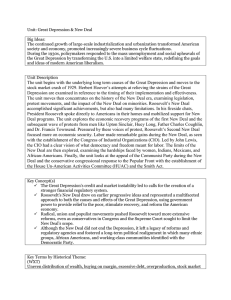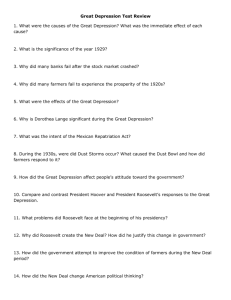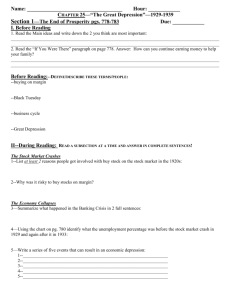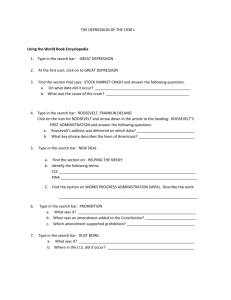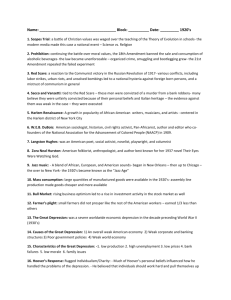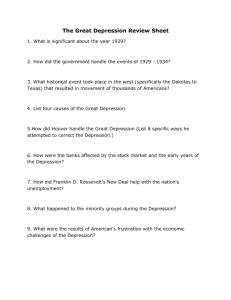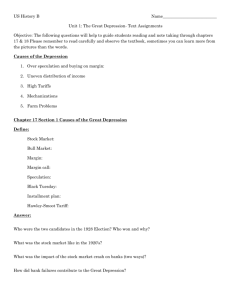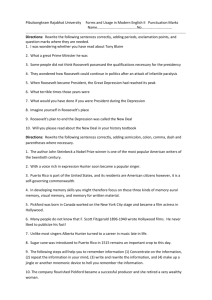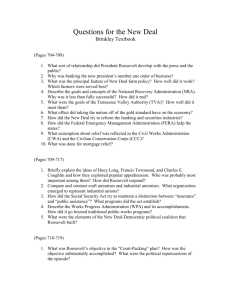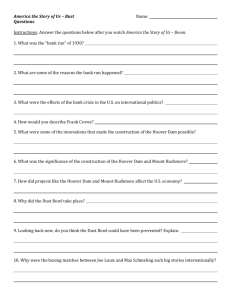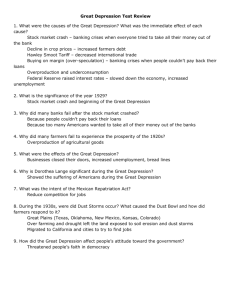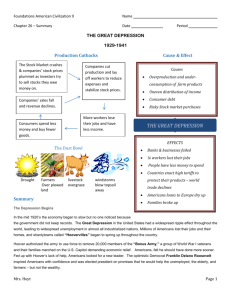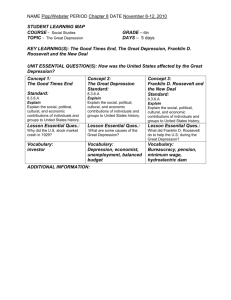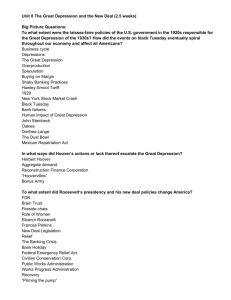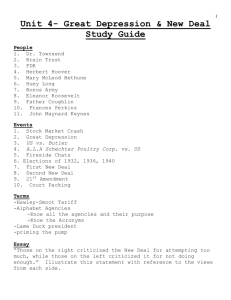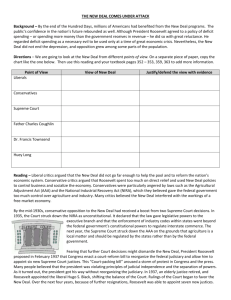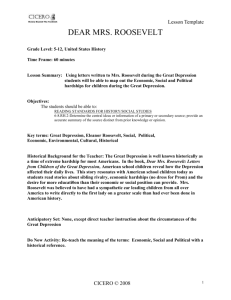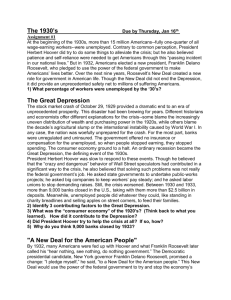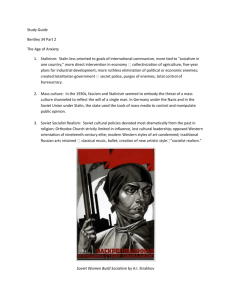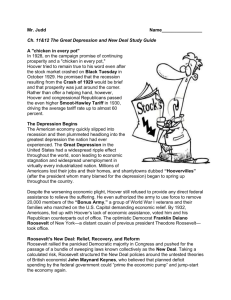Unit: Great Depression & New Deal Big Ideas: The continued growth
advertisement
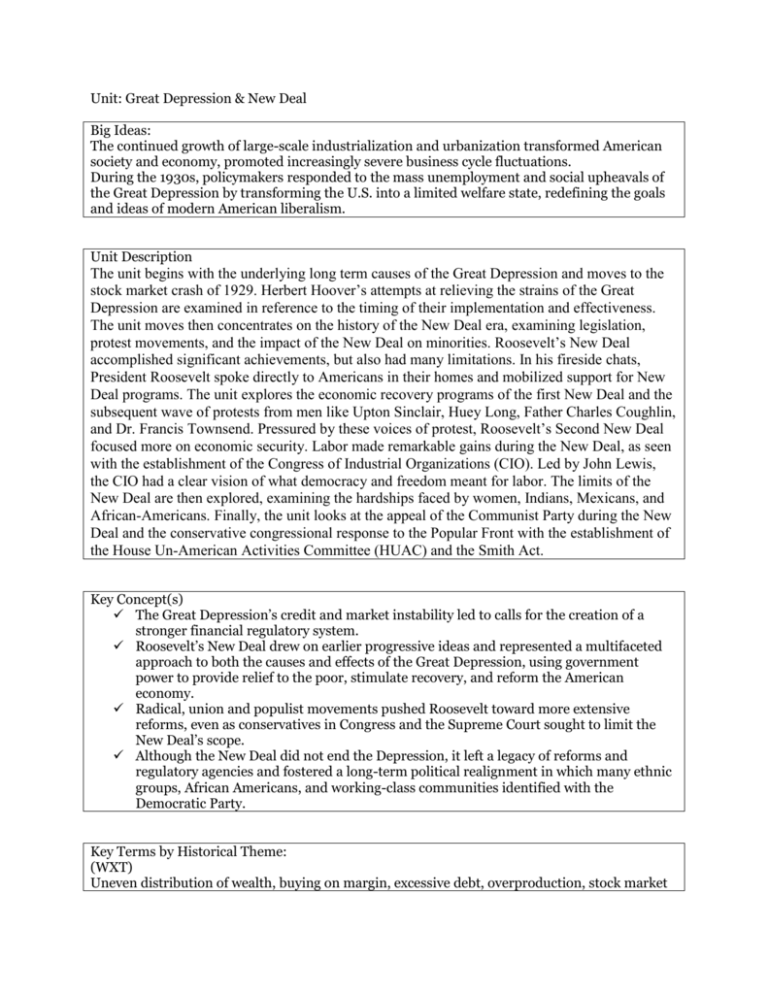
Unit: Great Depression & New Deal Big Ideas: The continued growth of large-scale industrialization and urbanization transformed American society and economy, promoted increasingly severe business cycle fluctuations. During the 1930s, policymakers responded to the mass unemployment and social upheavals of the Great Depression by transforming the U.S. into a limited welfare state, redefining the goals and ideas of modern American liberalism. Unit Description The unit begins with the underlying long term causes of the Great Depression and moves to the stock market crash of 1929. Herbert Hoover’s attempts at relieving the strains of the Great Depression are examined in reference to the timing of their implementation and effectiveness. The unit moves then concentrates on the history of the New Deal era, examining legislation, protest movements, and the impact of the New Deal on minorities. Roosevelt’s New Deal accomplished significant achievements, but also had many limitations. In his fireside chats, President Roosevelt spoke directly to Americans in their homes and mobilized support for New Deal programs. The unit explores the economic recovery programs of the first New Deal and the subsequent wave of protests from men like Upton Sinclair, Huey Long, Father Charles Coughlin, and Dr. Francis Townsend. Pressured by these voices of protest, Roosevelt’s Second New Deal focused more on economic security. Labor made remarkable gains during the New Deal, as seen with the establishment of the Congress of Industrial Organizations (CIO). Led by John Lewis, the CIO had a clear vision of what democracy and freedom meant for labor. The limits of the New Deal are then explored, examining the hardships faced by women, Indians, Mexicans, and African-Americans. Finally, the unit looks at the appeal of the Communist Party during the New Deal and the conservative congressional response to the Popular Front with the establishment of the House Un-American Activities Committee (HUAC) and the Smith Act. Key Concept(s) The Great Depression’s credit and market instability led to calls for the creation of a stronger financial regulatory system. Roosevelt’s New Deal drew on earlier progressive ideas and represented a multifaceted approach to both the causes and effects of the Great Depression, using government power to provide relief to the poor, stimulate recovery, and reform the American economy. Radical, union and populist movements pushed Roosevelt toward more extensive reforms, even as conservatives in Congress and the Supreme Court sought to limit the New Deal’s scope. Although the New Deal did not end the Depression, it left a legacy of reforms and regulatory agencies and fostered a long-term political realignment in which many ethnic groups, African Americans, and working-class communities identified with the Democratic Party. Key Terms by Historical Theme: (WXT) Uneven distribution of wealth, buying on margin, excessive debt, overproduction, stock market crash, Black Tuesday, Dow Jones index, Federal Reserve, postwar European debts, tariffs, Gross National Product, bank failure, Congress of Industrial Organization, John L Lewis, sit-down strikes, Fair Labor Standards Act, minimum wage (POL) Herbert Hoover, self reliance, Hawley-Smoot Tariff (1930), debt moratorium, Farm Board, Reconstruction Finance Corporation, Bonus March (1932), Twentieth-Amendment, Franklin Roosevelt, Eleanor Roosevelt, New deal, relief, recovery, reform, Brain Trust, Francis Perkins, Hundred Days, bank holiday, repeal of Prohibition, fireside chat, Federal Deposit Insurance Corporation, Public Works Administration, Harold Ickes, Civilian Conservation Corps, Tennessee Valley Authority, National Recovery Administration, Schechter v US, Securities and Exchange Commission, Federal Housing Administration, Works Progress Administration, Harry Hopkins, National Labor Relations (Wagner) Act (1935), Social Security Act (1935), election of 1936, New Deal coalition, John Maynard Keynes, recession of 1937, Father Charles Coughlin, Francis Townsend, Huey Long, Supreme Court reorganization plan, conservative coalition (POE) Depression mentality, Dust Bowl, Okies, John Steinbeck, Grapes of Wrath, Marian Anderson , Mary McLeod Bethune, Fair Employment Practices Committee, A. Philip Randolph, Indian Reorganization (Wheeler-Howard) Act (1934), Mexican deportation

